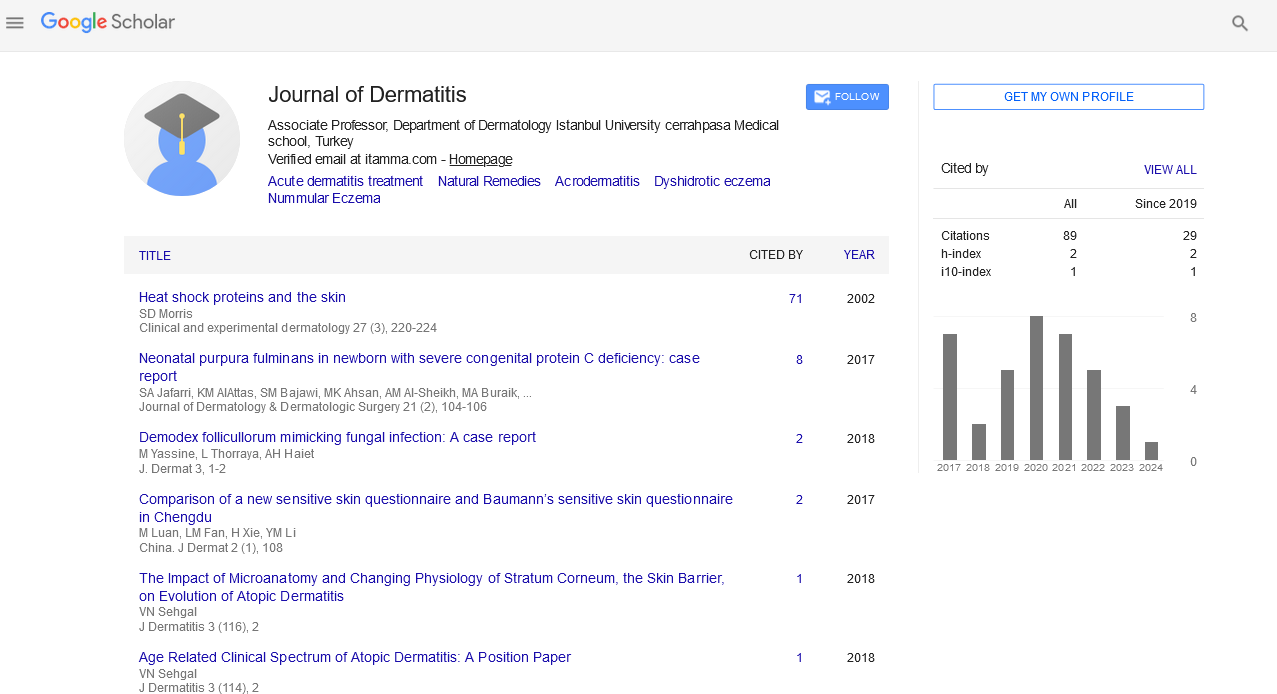Indexed In
- RefSeek
- Hamdard University
- EBSCO A-Z
- Euro Pub
- Google Scholar
Useful Links
Share This Page
Journal Flyer

Open Access Journals
- Agri and Aquaculture
- Biochemistry
- Bioinformatics & Systems Biology
- Business & Management
- Chemistry
- Clinical Sciences
- Engineering
- Food & Nutrition
- General Science
- Genetics & Molecular Biology
- Immunology & Microbiology
- Medical Sciences
- Neuroscience & Psychology
- Nursing & Health Care
- Pharmaceutical Sciences
Perspective - (2023) Volume 8, Issue 1
Etiology and Epidemiology of Chronic Skin Inflammation
Ikegami Shiori*Received: 02-Jan-2023, Manuscript No. JOD-23-19863; Editor assigned: 04-Jan-2023, Pre QC No. JOD-23-19863 (PQ); Reviewed: 18-Jan-2023, QC No. JOD-23-19863; Revised: 25-Jan-2023, Manuscript No. JOD-23-19863 (R); Published: 01-Feb-2023, DOI: 10.35248/2684-1436.23.08.176
Description
Skin inflammation and rashes can cause redness, pain, itching and dryness and be challenging to diagnose and manage. Dermatitis, poison ivy, poison oak, and drug rashes are a few examples of common inflammatory skin disorders. Doctors often classify skin conditions into one of four categories: acute dermatitis, non-acute dermatitis, chronic dermatitis and acute alopecia. Acute dermatitis is a common skin condition that develops after a minor injury, such as a minor scrape or slight burn. During acute skin inflammation, normal skin tissues appear inflamed. As the skin heals, normal skin tissues appear normal and look normal during subsequent non-inflammatory periods. However, skin inflammation can cause itching, skin redness, swelling, skin thickening and discoloration. Skin inflammation can be chronic or acute. Chronic skin inflammation can develop into a chronic skin disorder. Acute skin inflammation occurs when an injury or an illness causes the skin to suddenly become inflamed. Patients suffering from skin inflammation must frequently take preventive steps to prevent problems such as infection or prolonged skin redness and irritation. With ongoing skin inflammation, it is essential to get a skin inspection by a physician as soon as possible.
Infections and rashes are not the only issues that can cause skin redness. For example, a skin lesion caused by an infection or another skin disorder can also cause skin redness. A skin lesion is a skin condition that involves a wound that is caused by either an injury or other skin disorders. The skin lesion might be associated with a skin rash, irritation, swelling, redness, skin discoloration or infection. In some cases, skin lesions caused by infectious diseases such as herpes are not visible. If anybody has an acute skin rash, they need to get medical attention quickly. Although the rash might not be severe and would not require treatment, notice symptoms that are new or skin reaction after treated for a skin condition, they need to see a doctor immediately.
The skin redness is often the first skin condition patients notice in chronic dermatitis or related conditions. To start with, some doctors call the skin redness associated with chronic dermatitis sebaceous hyperpigmentation or erythema vasculitis. It is called skin inflammation, erythema vasculitis, skin redness, skin inflammation or rash. Patients suffering from a chronic skin rash sometimes treat the condition with the topical treatment tetracycline. However, in some cases, it is necessary to have medical treatment. With treatment, skin redness can be reduced or eliminated. The skin redness can be reduced or eliminated during antibiotic treatment, when steroids are used, or when doctors apply a steroid cream or an ointment containing corticosteroids to reduce inflammation. If treatment is not successful, skin redness can be treated with drug treatment. To treat the redness caused by inflammation of the skin, a doctor might prescribe certain topical treatments such as topical corticosteroids, oral corticosteroids or antibiotics. Antihistamines are also commonly used to treat skin inflammation. For example, to treat a skin redness caused by poison ivy, prescription antihistamines or an oral antihistamine is recommended. The antihistamine therapy is usually effective for the skin redness caused by poison ivy, although the antihistamine therapy is not always effective for other types of skin redness. A doctor might also prescribe a topical steroid to treat skin redness caused by psoriasis or eczema. The topical steroid can be taken orally or applied to the skin in a cream form.
For skin inflammation associated with skin conditions, doctor might recommend topical and oral treatments that are used to reduce redness and the itching associated with skin inflammation. For example, steroid ointments or topical steroids that reduce redness and itching are often used for treating skin inflammation. An ointment containing corticosteroids is also used to treat skin redness caused by skin diseases such as skin inflammation and psoriasis. However, a skin redness caused by skin conditions might be more difficult to treat and even if the skin redness is treated successfully, the skin might still be red and inflamed. To treat skin redness, skin doctors sometimes prescribe systemic drugs that can be taken by mouth to reduce redness in the skin.
Citation: Shiori I (2023) Etiology and Epidemiology of Chronic Skin Inflammation. J Dermatitis.8:176.
Copyright: © 2023 Shiori I. This is an open-access article distributed under the terms of the Creative Commons Attribution License, which permits unrestricted use, distribution, and reproduction in any medium, provided the original author and source are credited.

